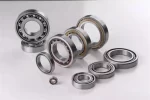Selection and optimization of bearing sealing method
Introduction
Bearing sealing is an essential aspect of ensuring the longevity and performance of bearings in various industrial applications. The sealing method used for bearings plays a crucial role in preventing contaminants from entering and retaining lubrication within the bearing assembly. In this article, we will discuss the selection and optimization of bearing sealing methods to maximize efficiency and reliability.
Factors influencing bearing sealing method selection
When selecting a bearing sealing method, several factors need to be taken into consideration. Firstly, the operating environment must be assessed. Factors such as temperature, humidity, and the presence of corrosive substances can significantly affect the performance of the bearing seals. Secondly, the speed and load requirements of the application play a role in determining the appropriate sealing method. High-speed and heavy-load applications may require more advanced sealing solutions. Finally, the type of lubricant used and the desired level of sealing effectiveness also influence the selection process.
Types of bearing sealing methods
There are various types of bearing sealing methods available, each with its own advantages and limitations. One commonly used sealing method is contact seals, which rely on direct contact between the seal and the bearing components to achieve effective sealing. These seals can be further divided into lip seals, labyrinth seals, and V-ring seals, among others. Another widely used method is non-contact seals, such as shield seals and gap seals, which do not rely on direct contact and offer reduced friction and heat generation. Additionally, there are specialized sealing methods like magnetic or air seals that are suitable for specific applications.
Optimization techniques for bearing sealing
Optimizing the sealing method can significantly enhance the performance and durability of bearings. One approach is to improve the material selection for the seals. Materials with excellent resistance to wear, heat, and corrosion can extend the lifespan of the seals and reduce maintenance requirements. Another technique involves refining the seal design to minimize friction and maximize sealing effectiveness. Advanced engineering tools like computer-aided design (CAD) and finite element analysis (FEA) can be utilized to optimize the seal geometry and ensure a precise fit. Additionally, implementing regular inspection and maintenance routines can help identify any potential issues and ensure the seals remain in optimal condition.
Conclusion
In conclusion, selecting and optimizing the bearing sealing method is crucial for achieving long-lasting and efficient performance of bearings. Considering factors such as operating environment, speed, load, and lubricant requirements is vital when choosing the appropriate sealing method. Furthermore, exploring various sealing options, including contact and non-contact seals, allows for customization based on specific application needs. By utilizing optimization techniques like material selection, seal design improvements, and regular maintenance, the reliability and longevity of bearings can be maximized. Properly sealed bearings contribute to enhanced efficiency, reduced downtime, and cost savings in industrial applications.
.webp)
